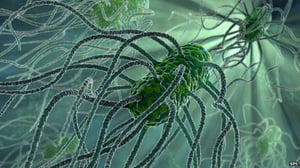 How do you break open bacterial cells in the lab? While the enzyme lysozyme is mainly responsible for lysing bacterial cells in nature, you can achieve the same effect by using particular enzymes, detergents, and chaotropic agents, and/or certain mechanical methods (e.g., sonication, repeated freezing and thawing, filtration, etc.).
How do you break open bacterial cells in the lab? While the enzyme lysozyme is mainly responsible for lysing bacterial cells in nature, you can achieve the same effect by using particular enzymes, detergents, and chaotropic agents, and/or certain mechanical methods (e.g., sonication, repeated freezing and thawing, filtration, etc.).
General Protocol for Preparing Bacterial Lysate under Native Conditions
- Harvest cells from the bacterial culture by centrifugation (5000 rpm for 10 minutes or 6000 rpm for 5 minutes). Aspirate the supernatant and freeze the resulting pellet at -70ºC
- Resuspend the pellet/bacterial cells in 2 ml MQ grade water and transfer the mixture to a clean universal tube.
- Add lysozyme and incubate on ice for 30 minutes, at 30ºC for 15 minutes or until the mixture becomes very viscous. Use BL21 for bacterial cells that are resistant to lysozyme (e.g., MC1061).
- Sonicate the sample on ice using three 10-second bursts at high intensity and let the mixture cool down for 30 seconds on ice between each burst. At the end of this step, the sample should lose its viscosity as the DNA is sheared. Note: Avoid extended periods of sonication and make sure the microtip is immersed by about 1 cm in the mixture to prevent frothing which may lead to protein denaturation.
If you wish to sonicate the mixture at medium intensity, make sure you flash freeze the lysate in liquid nitrogen and quickly thaw it at 37ºC. You can also use methanol dry ice slurry for this purpose. Repeat this rapid freeze-thaw cycle two more times.
- Using the prepared lysis buffer, dilute the lysate to approximately 50 ml. Centrifuge at 35,000 rpm for 30 minutes at 4ºC to pellet the remaining cellular debris in the lysate. Transfer the supernatant to new tubes.
- Are there insoluble proteins in the pellet? If there are any, prepare a denatured lysate followed by the denatured purification protocol to recover them.
- Remove 5 µl of the lysate for SDS-PAGE analysis and store remaining lysate on ice. Note: For overexpression analysis of E. coli whole cell lysate, boil the cell pellet of 1 ml culture with 1 µl sample buffer at 100ºC for 3 minutes. Centrifuge at maximum speed for 1 minute (room temperature) and load 10 to 15 µl on SDS-PAGE gel.
Preparing the Lysis Buffer
This lysis buffer is recommended when working with His-tagged proteins. The ideal lysis buffers for other tagged proteins (e.g., MBP) may vary.
Recommended Lysis Buffer
- 140mM sodium chloride (NaCl)
- 7mM potassium chloride (KCl)
- 10mM sodium phosphate dibasic (Na2HPO4)
- 8mM KH2PO4
- pH 7.3 (i.e. PBS)with 10 mM imidazole
Or:
- 100mM sodium chloride (NaCl)
- 25mM Tris HCl
- pH 8.0, 10 mM imidazole
- optional: 0.02% NaN3(azide), protease inhibitors
Other Optional Additives
- 1mM PMSF or protease inhibitor cocktail (1:200). Don’t use EDTA when working with his-tagged proteins.
- DNAse 100U/ml or 25-50ug/ml. Incubate for 10 min at 4°C in the presence of 10mM MgCl2.For optimal effect, add DNAse right after sonication. However, DNase is known to interfere with some downstream applications so always practice due diligence if you plan on using it.
- Lysozyme 0.2mg/ml final. Incubate for 10min at 4°C.
- ßME, DTT or DTE (up to 10mM for proteins with many cysteines).
- 1-2% Triton X-100 or NP40. This prevents the aggregation of hydrophobic and membrane proteins. However, when using detergents, make sure you use one that does not affect the biological activity of the target protein.
- 10% glycerol to stabilize and prevent aggregation of the protein. Please note that glycerol may affect the results of NMR and structure studies.
Using additives is not normally required, especially if using protease-deficient bacteria (e.g., BL21).






